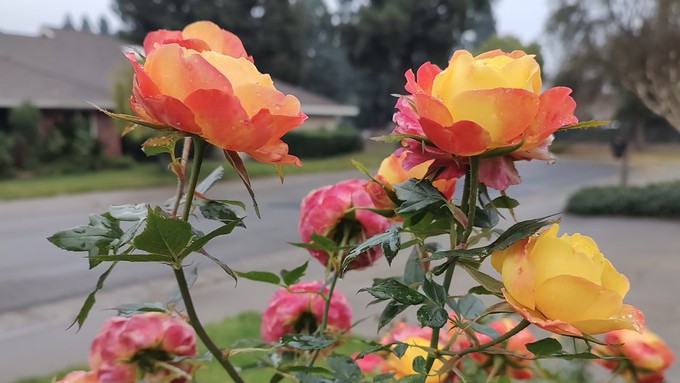
It's time to start pruning; how to cue bushes to take a winter nap

These Rainbow Sunblaze roses are in full bloom on Dec. 27, bright spots on a rainy winter day. Debbie Arrington
It’s almost New Year’s Day and my roses are still (stubbornly) in bloom. Blame our mild winter weather.
Near-freezing temperatures cue roses (and other shrubs and trees) to drop their leaves and enter winter dormancy. But when temperatures stay above normal, these deciduous plants keep on growing and producing more flowers. They feel like it’s still October, not almost January.
My roses, it seems, are pretty accurate predictors of temperature. This has been a relatively warm December in Sacramento.
Through Tuesday, December has averaged more than 3 degrees warmer than our average median (50.7 degrees vs. 47.4 average), according to the National Weather Service. And our December daytime highs have been almost 5 degrees above normal (61 degrees vs. 56.2 average).
Meanwhile, our nightly lows have been warm, too (40.3 degrees vs. 38.6 average). Although we’ve flirted with frost, Downtown Sacramento has not recorded one night under 32 degrees so far this month.
We can’t do anything about the weather. But we can go ahead and prune our roses – they need it. Consider pruning as telling your roses to take a forced vacation; they need to take a winter break.
Pruning is crucial for healthy rose bushes. It’s a chance to rid the plant of fungal-bearing foliage and eliminate diseased canes. It improves air flow in and around the bush (another way to cut down on fungal disease) and also keeps bushes from overwhelming their space.
Normal pruning season in Sacramento runs from early- to mid-December through early February. By late February, bushes will be pushing out lots of new growth. (And with this warmth, bushes already are sprouting new growth.)
What happens if you don’t prune? New growth will sprout out of the top of the old growth. If your bushes are already 5 or 6 feet tall, they’ll tower overhead by spring – and just keep going.
Pruning is crucial to disease control. Old foliage (on or off the bush) may harbor fungal spores that will immediately infect healthy new growth (especially if there’s moisture in the air – like today). And in an effort to shed damaged foliage, the bush may shed all its leaves next spring – when the bush needs those leaves to produce energy – and roses.
Speaking of rain, recent storms have really brought out botrytis (gray mold). It turns rose buds into brown yucky mush. Before pruning, pluck off infected blooms and petals and discard.
Here are more tips from master rosarian Baldo Villegas on how to prepare for pruning:
* Check your irrigation system to make sure that all roses get adequate water. Decrease or stop watering once rain starts.
* Let hips form to encourage dormancy. They also provide colorful interest in the late fall and winter garden.
* Remove any diseased blooms or fallen petals and foliage from the ground around the roses. That cuts down on fungal disease.
* Acquire the proper tools for rose pruning and winter chores: One pair of bypass pruning shears, one pair of goatskin gloves, one pair of knee pads, one pair of 24-inch loppers, one folding pruning saw.
* Find spots to plant more roses. It’s the start of bare-root season, too!
Comments
0 comments have been posted.Sacramento Digs Gardening to your inbox.
Sites We Like
Garden Checklist for week of July 21
Your garden needs you!
* Keep your vegetable garden watered, mulched and weeded. Water before 8 a.m. to reduce the chance of fungal infection and to conserve moisture.
* Feed vegetable plants bone meal, rock phosphate or other fertilizers high in phosphate to stimulate more blooms and fruiting. (But wait until daily high temperatures drop out of the 100s.)
* Don’t let tomatoes wilt or dry out completely. Give tomatoes a deep watering two to three times a week.
* Harvest vegetables promptly to encourage plants to produce more. Squash especially tends to grow rapidly in hot weather. Keep an eye on zucchini.
* Pinch back chrysanthemums for bushy plants and more flowers in September.
* Remove spent flowers from roses, daylilies and other bloomers as they finish flowering.
* Pinch off blooms from basil so the plant will grow more leaves.
* Cut back lavender after flowering to promote a second bloom.
* It's not too late to add a splash of color. Plant petunias, snapdragons, zinnias and marigolds.
* From seed, plant corn, pumpkins, radishes, winter squash and sunflowers.